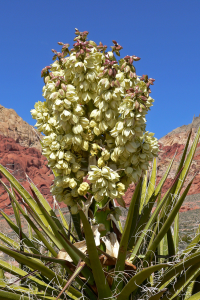Yucca shidigera is pollinated by the Yucca moth, which spreads pollen and fertilizes flowers while in the process of laying its eggs inside the flower. The larvae then hatch in the fruit and feed on the seeds.
Photo Credit: © Nyenyec via Wikimedia Commons
Yucca schidigera
Common Name: Mojave yucca
Other Common Names: Izote de Ensenada, Spanish dagger
Plant Functional Group: Evergreen broadleaf
Class > Order > Family: Magnoliopsida > Asparagales > Asparagaceae
What does the species look like?
This is a small evergreen plant up to 5 meters tall. Its leaves are up to 150 centimeters long, pointy, and very rigid. They are arranged in a spiral on top of a basal trunk. Flowers are 3 to 5 centimeters long, white, and bell-shaped in dense clusters at the end of a central stalk. The flowers are bisexual, having both male and female reproductive parts in each flower.
Where is the species found?
States & Provinces
AZ, CA, NV, UT
Which phenophases should I observe?
Do you see...?
Flowers
Flowers or flower buds More...
How many flowers and flower buds are present? For species in which individual flowers are clustered in flower heads, spikes or catkins (inflorescences), simply estimate the number of flower heads, spikes or catkins and not the number of individual flowers.
Less than 3 3 to 10 11 to 100 101 to 1,000 1,001 to 10,000 More than 10,000
Open flowers More...
What percentage of all fresh flowers (buds plus unopened plus open) on the plant are open? For species in which individual flowers are clustered in flower heads, spikes or catkins (inflorescences), estimate the percentage of all individual flowers that are open.
Less than 5% 5-24% 25-49% 50-74% 75-94% 95% or more
Fruits
Fruits Yucca schidigera , the fruit is a fleshy capsule, sometimes constricted, that changes from fleshy green to leathery tan, grayish-brown or brown.More...
How many fruits are present?
Less than 3 3 to 10 11 to 100 101 to 1,000 1,001 to 10,000 More than 10,000
Ripe fruits Yucca schidigera , a fruit is considered ripe when it has turned leathery tan, grayish-brown or brown.More...
What percentage of all fruits (unripe plus ripe) on the plant are ripe?
Less than 5% 5-24% 25-49% 50-74% 75-94% 95% or more
Recent fruit or seed drop More...
How many mature fruits have dropped seeds or have completely dropped or been removed from the plant since your last visit?
Less than 3 3 to 10 11 to 100 101 to 1,000 1,001 to 10,000 More than 10,000
What do these phenophases look like?
There is currently no photoguide available for this species. If you'd like help us create one, use the guidance document and species template provided here . Then send it via email to education@usanpn.org when it is complete.
